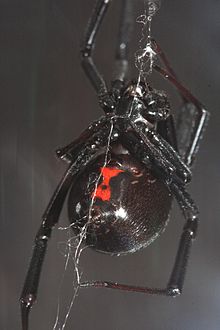Latrodectus hesperus
| Latrodectus hesperus | |
|---|---|
 |
|
| Latrodectus hesperus female | |
| Scientific classification | |
| Kingdom: | Animalia |
| Phylum: | Arthropoda |
| Subphylum: | Chelicerata |
| Class: | Arachnida |
| Order: | Araneae |
| Infraorder: | Araneomorphae |
| Family: | Theridiidae |
| Genus: | Latrodectus |
| Species: | L. hesperus |
| Binomial name | |
|
Latrodectus hesperus Chamberlin & Ivie, 1935 |
|
Latrodectus hesperus, the western black widow spider or western widow, is a venomous spider species found in western regions of North America. The female's body is 14–16 mm (1/2 in) in length and is black, often with an hourglass-shaped red mark on the lower abdomen. This "hourglass" mark can be yellow, and on rare occasions, white. The male of the species is around half this length and generally a tan color with lighter striping on the abdomen. The population was previously described as a subspecies of Latrodectus mactans and it is closely related to the northern species Latrodectus variolus. The species, as with others of the genus, build irregular or "messy" webs: Unlike the spiral webs or the tunnel-shaped webs of other spiders, the strands of a Latrodectus web have no apparent organization. Female black widows have potent venom composed of neurotoxins. Fatalities usually only happen with children and the elderly, however medical treatment may be required for others as well. However, the male black widow is harmless to humans. The female's consumption of the male after courtship, a cannibalistic and suicidal behavior observed in Latrodectus hasseltii (Australia's redback), is rare in this species. Male western widows may breed several times during their relatively short lifespans. Males are known to show preference for mating with well-fed females over starved ones, taking cues from the females' webs.
Latrodectus hesperus can be found in western regions of North America. In Canada it can be found from British Columbia, to Manitoba They are most commonly found near the Canada-US border, as well less commonly throughout prairies regions of the Canadian Prairies in Western Canada.
Female stimulates by contact with male webs Male and female Latrodectus hesperus produce sexually specific scents which are combined with their silk; each sex responds by initiating mating when it comes in contact with a web of the opposite sex.
...
Wikipedia
